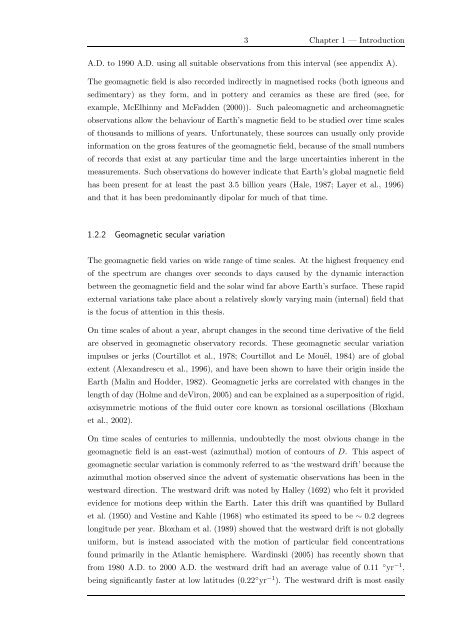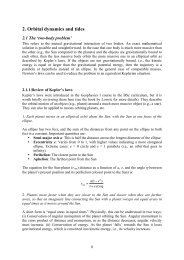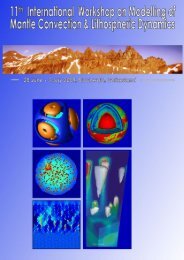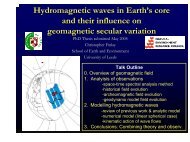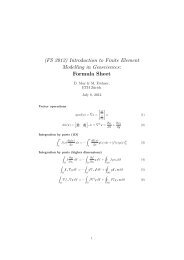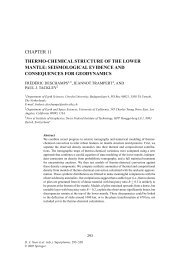Hydromagnetic waves in Earth's core and their influence on ...
Hydromagnetic waves in Earth's core and their influence on ...
Hydromagnetic waves in Earth's core and their influence on ...
Create successful ePaper yourself
Turn your PDF publications into a flip-book with our unique Google optimized e-Paper software.
3 Chapter 1 — Introducti<strong>on</strong>A.D. to 1990 A.D. us<str<strong>on</strong>g>in</str<strong>on</strong>g>g all suitable observati<strong>on</strong>s from this <str<strong>on</strong>g>in</str<strong>on</strong>g>terval (see appendix A).The geomagnetic field is also recorded <str<strong>on</strong>g>in</str<strong>on</strong>g>directly <str<strong>on</strong>g>in</str<strong>on</strong>g> magnetised rocks (both igneous <str<strong>on</strong>g>and</str<strong>on</strong>g>sedimentary) as they form, <str<strong>on</strong>g>and</str<strong>on</strong>g> <str<strong>on</strong>g>in</str<strong>on</strong>g> pottery <str<strong>on</strong>g>and</str<strong>on</strong>g> ceramics as these are fired (see, forexample, McElh<str<strong>on</strong>g>in</str<strong>on</strong>g>ny <str<strong>on</strong>g>and</str<strong>on</strong>g> McFadden (2000)). Such paleomagnetic <str<strong>on</strong>g>and</str<strong>on</strong>g> archeomagneticobservati<strong>on</strong>s allow the behaviour of Earth’s magnetic field to be studied over time scalesof thous<str<strong>on</strong>g>and</str<strong>on</strong>g>s to milli<strong>on</strong>s of years. Unfortunately, these sources can usually <strong>on</strong>ly provide<str<strong>on</strong>g>in</str<strong>on</strong>g>formati<strong>on</strong> <strong>on</strong> the gross features of the geomagnetic field, because of the small numbersof records that exist at any particular time <str<strong>on</strong>g>and</str<strong>on</strong>g> the large uncerta<str<strong>on</strong>g>in</str<strong>on</strong>g>ties <str<strong>on</strong>g>in</str<strong>on</strong>g>herent <str<strong>on</strong>g>in</str<strong>on</strong>g> themeasurements. Such observati<strong>on</strong>s do however <str<strong>on</strong>g>in</str<strong>on</strong>g>dicate that Earth’s global magnetic fieldhas been present for at least the past 3.5 billi<strong>on</strong> years (Hale, 1987; Layer et al., 1996)<str<strong>on</strong>g>and</str<strong>on</strong>g> that it has been predom<str<strong>on</strong>g>in</str<strong>on</strong>g>antly dipolar for much of that time.1.2.2 Geomagnetic secular variati<strong>on</strong>The geomagnetic field varies <strong>on</strong> wide range of time scales. At the highest frequency endof the spectrum are changes over sec<strong>on</strong>ds to days caused by the dynamic <str<strong>on</strong>g>in</str<strong>on</strong>g>teracti<strong>on</strong>between the geomagnetic field <str<strong>on</strong>g>and</str<strong>on</strong>g> the solar w<str<strong>on</strong>g>in</str<strong>on</strong>g>d far above Earth’s surface. These rapidexternal variati<strong>on</strong>s take place about a relatively slowly vary<str<strong>on</strong>g>in</str<strong>on</strong>g>g ma<str<strong>on</strong>g>in</str<strong>on</strong>g> (<str<strong>on</strong>g>in</str<strong>on</strong>g>ternal) field thatis the focus of attenti<strong>on</strong> <str<strong>on</strong>g>in</str<strong>on</strong>g> this thesis.On time scales of about a year, abrupt changes <str<strong>on</strong>g>in</str<strong>on</strong>g> the sec<strong>on</strong>d time derivative of the fieldare observed <str<strong>on</strong>g>in</str<strong>on</strong>g> geomagnetic observatory records. These geomagnetic secular variati<strong>on</strong>impulses or jerks (Courtillot et al., 1978; Courtillot <str<strong>on</strong>g>and</str<strong>on</strong>g> Le Mouël, 1984) are of globalextent (Alex<str<strong>on</strong>g>and</str<strong>on</strong>g>rescu et al., 1996), <str<strong>on</strong>g>and</str<strong>on</strong>g> have been shown to have <str<strong>on</strong>g>their</str<strong>on</strong>g> orig<str<strong>on</strong>g>in</str<strong>on</strong>g> <str<strong>on</strong>g>in</str<strong>on</strong>g>side theEarth (Mal<str<strong>on</strong>g>in</str<strong>on</strong>g> <str<strong>on</strong>g>and</str<strong>on</strong>g> Hodder, 1982). Geomagnetic jerks are correlated with changes <str<strong>on</strong>g>in</str<strong>on</strong>g> thelength of day (Holme <str<strong>on</strong>g>and</str<strong>on</strong>g> deVir<strong>on</strong>, 2005) <str<strong>on</strong>g>and</str<strong>on</strong>g> can be expla<str<strong>on</strong>g>in</str<strong>on</strong>g>ed as a superpositi<strong>on</strong> of rigid,axisymmetric moti<strong>on</strong>s of the fluid outer <str<strong>on</strong>g>core</str<strong>on</strong>g> known as torsi<strong>on</strong>al oscillati<strong>on</strong>s (Bloxhamet al., 2002).On time scales of centuries to millennia, undoubtedly the most obvious change <str<strong>on</strong>g>in</str<strong>on</strong>g> thegeomagnetic field is an east-west (azimuthal) moti<strong>on</strong> of c<strong>on</strong>tours of D. This aspect ofgeomagnetic secular variati<strong>on</strong> is comm<strong>on</strong>ly referred to as ‘the westward drift’ because theazimuthal moti<strong>on</strong> observed s<str<strong>on</strong>g>in</str<strong>on</strong>g>ce the advent of systematic observati<strong>on</strong>s has been <str<strong>on</strong>g>in</str<strong>on</strong>g> thewestward directi<strong>on</strong>. The westward drift was noted by Halley (1692) who felt it providedevidence for moti<strong>on</strong>s deep with<str<strong>on</strong>g>in</str<strong>on</strong>g> the Earth. Later this drift was quantified by Bullardet al. (1950) <str<strong>on</strong>g>and</str<strong>on</strong>g> Vest<str<strong>on</strong>g>in</str<strong>on</strong>g>e <str<strong>on</strong>g>and</str<strong>on</strong>g> Kahle (1968) who estimated its speed to be ∼ 0.2 degreesl<strong>on</strong>gitude per year. Bloxham et al. (1989) showed that the westward drift is not globallyuniform, but is <str<strong>on</strong>g>in</str<strong>on</strong>g>stead associated with the moti<strong>on</strong> of particular field c<strong>on</strong>centrati<strong>on</strong>sfound primarily <str<strong>on</strong>g>in</str<strong>on</strong>g> the Atlantic hemisphere. Ward<str<strong>on</strong>g>in</str<strong>on</strong>g>ski (2005) has recently shown thatfrom 1980 A.D. to 2000 A.D. the westward drift had an average value of 0.11 ◦ yr −1 ,be<str<strong>on</strong>g>in</str<strong>on</strong>g>g significantly faster at low latitudes (0.22 ◦ yr −1 ). The westward drift is most easily


